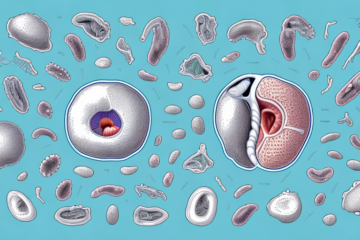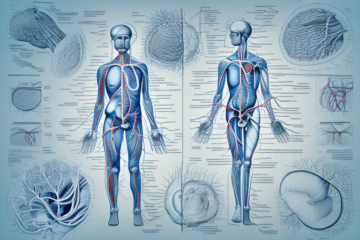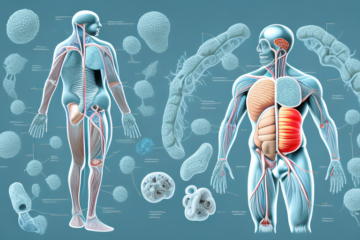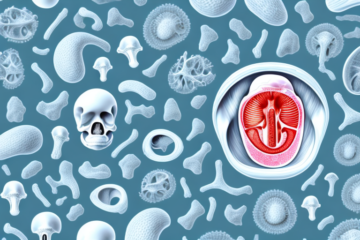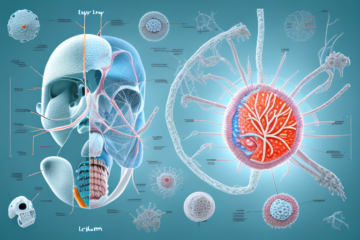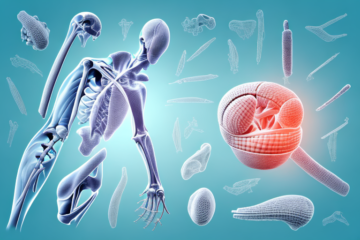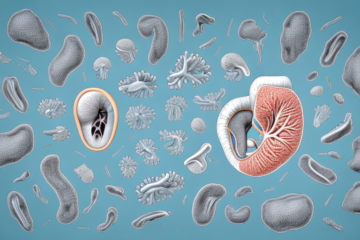The interstitium is a newly discovered organ in the human body, and its role in maintaining homeostasis has been gaining much attention in the scientific community. In this article, we will delve into the basics of interstitium, its anatomy, function, and associated medical conditions.
Understanding the Basics of Interstitium
The interstitium is a network of fluid-filled spaces that exist between cells and tissues in the body. Previously, it was thought to be just a connective tissue layer, but recent research has shown that it is an independent organ system. This network is present throughout the body and helps transport fluids and cells between organs and tissues. It is essentially a three-dimensional web of collagen and elastin fibers that supports cells and provides structural integrity to the tissues.
Studies have also suggested that the interstitium may play a role in the spread of cancer cells. As the interstitium is connected to the lymphatic system, cancer cells may use this network to move from one part of the body to another. This discovery has led to further research on how the interstitium can be targeted to prevent the spread of cancer and improve treatment outcomes.
The Role of Interstitium in Human Body
The interstitium plays a crucial role in maintaining the fluid balance and temperature of the body. It also supports the lymphatic system, which is an essential part of our immune system. The interstitial fluid in the network helps transport nutrients, wastes, and hormones between cells and organs. It also helps filter impurities and toxins and removes them from the body.
Recent studies have shown that the interstitium may also play a role in the spread of cancer cells. The fluid-filled spaces in the interstitium may provide a pathway for cancer cells to move from one part of the body to another. This discovery has led to new research on how to target and treat cancer cells that use the interstitium to spread.
In addition to its role in cancer, the interstitium is also being studied for its potential in regenerative medicine. Researchers are exploring how the interstitial fluid and network can be used to promote tissue regeneration and repair. This could lead to new treatments for injuries and diseases that currently have limited options for healing.
Anatomy of Interstitium: Structure and Location
The interstitium is a complex network of fluid-filled spaces that lies between the cells and tissues in the body. It is found throughout the body, including the skin, lungs, gastrointestinal tract, and lymphatic system. The interstitial spaces are composed of collagen and elastin fibers, as well as various cell types like fibroblasts, macrophages and endothelial cells.
The interstitium plays a crucial role in maintaining the structural integrity of the body’s tissues and organs. It acts as a cushion, protecting the cells and tissues from damage caused by physical stress or trauma. Additionally, the interstitial spaces serve as a conduit for the movement of fluids, nutrients, and waste products between the cells and the bloodstream.
Recent research has also suggested that the interstitium may play a role in the spread of cancer cells. Studies have shown that cancer cells can migrate through the interstitial spaces and use them as a pathway to other parts of the body. This has led to new approaches in cancer treatment that target the interstitium to prevent the spread of cancer cells.
What You Need to Know About Interstitial Fluid
Interstitial fluid is the fluid that fills the interstitial spaces between cells in the body. It is a key component of the extracellular fluid, which includes plasma and lymph. The interstitial fluid contains electrolytes, nutrients, oxygen, and metabolic waste products.
One important function of interstitial fluid is to facilitate the exchange of nutrients and waste products between cells and blood vessels. It also helps to maintain the balance of electrolytes and pH levels in the body. Any disruption in the composition or flow of interstitial fluid can lead to various health problems, such as edema, dehydration, and acid-base imbalances. Therefore, it is crucial to maintain a healthy interstitial fluid balance through proper hydration, nutrition, and exercise.
How Does the Interstitium Work in Maintaining Homeostasis?
The interstitial fluid maintains the balance of water, electrolytes, and nutrients in the body. It also helps regulate the pH of the body fluids and maintains the proper osmotic pressure necessary for cellular functions. The interstitium also plays a role in the exchange of gases between the blood and tissues, helping to regulate respiration.
In addition to its role in maintaining fluid and electrolyte balance, the interstitium also serves as a pathway for immune cells to travel throughout the body. This allows for the immune system to quickly respond to infections or injuries in various tissues. Furthermore, recent research suggests that the interstitium may play a role in the spread of cancer cells, as it provides a network of channels for cells to move through. Understanding the interstitium and its functions is crucial for maintaining overall health and preventing disease.
What Are the Types of Cells Found in the Interstitium?
The interstitium contains a variety of cells, including fibroblasts, macrophages, and endothelial cells. Fibroblasts produce connective tissue fibers that provide structural support to the interstitium. Macrophages are immune cells that help eliminate microbes and other foreign particles from the interstitial fluid. Endothelial cells line the walls of blood vessels and play a role in regulating blood flow.
In addition to these cells, the interstitium also contains mast cells, which are involved in the body’s allergic response. Mast cells release histamine and other chemicals that cause inflammation and swelling in response to an allergen. These cells are particularly abundant in areas of the interstitium that are exposed to the external environment, such as the skin and respiratory tract.
Understanding the Connection Between Interstitium and Lymphatic System
The interstitium is closely linked to the lymphatic system, which helps remove excess fluid, waste, and unwanted substances from the body. The lymphatic system relies on the interstitial fluid to move lymph through the body. The lymphatic system collects excess interstitial fluid and returns it to the blood circulation system.
Recent studies have shown that the interstitium may play a role in the spread of cancer cells. It has been discovered that cancer cells can travel through the interstitial fluid and enter the lymphatic system, which can then spread the cancer to other parts of the body. This new understanding of the interstitium’s role in cancer metastasis has led to further research and potential new treatments for cancer.
Importance of Interstitial Fluid in Cancer Metastasis
Interstitial fluid plays a crucial role in the spread of cancer to other parts of the body. Cancer cells can travel through the interstitial spaces to reach distant organs and tissues. The composition of the interstitial fluid can also influence the ability of cancer cells to invade and grow in new areas of the body.
Recent studies have shown that the interstitial fluid can also affect the response of cancer cells to chemotherapy and other treatments. The fluid can act as a barrier, preventing drugs from reaching the cancer cells or reducing their effectiveness. Researchers are now exploring ways to modify the composition of the interstitial fluid to improve the delivery of cancer treatments.
Furthermore, the interstitial fluid can also contain immune cells that play a role in the body’s defense against cancer. However, cancer cells can manipulate the immune cells and use them to promote their own growth and spread. Understanding the complex interactions between cancer cells and the interstitial fluid is crucial for developing new strategies to prevent and treat cancer metastasis.
Common Medical Conditions Associated with Interstitium Dysfunction
There are several medical conditions associated with interstitial dysfunction. Some of the most common disorders include lymphedema, fibrosis, and interstitial lung disease. In these conditions, the interstitial fluid accumulates in tissues, leading to inflammation and damage to organ function.
Another medical condition associated with interstitial dysfunction is systemic sclerosis, also known as scleroderma. This autoimmune disease affects the connective tissue and can cause thickening and hardening of the skin, as well as damage to internal organs such as the lungs, heart, and kidneys.
Additionally, interstitial cystitis is a chronic bladder condition that can cause pain and discomfort in the pelvic area. It is believed to be caused by inflammation and damage to the bladder lining, leading to increased sensitivity and pain.
Diagnostic Tests Used for Detecting Interstitial Diseases
Diagnosing interstitial diseases can be challenging. Several diagnostic tests can help detect interstitial dysfunction, including pulmonary function tests, chest imaging, and biopsy. Blood tests can also indicate inflammation or abnormal function of organs such as the liver or kidneys.
Pulmonary function tests measure how well the lungs are functioning. These tests can detect changes in lung capacity and airflow, which can indicate interstitial lung disease. Chest imaging, such as X-rays or CT scans, can also help diagnose interstitial diseases by showing abnormalities in the lungs.
In some cases, a biopsy may be necessary to confirm a diagnosis. A biopsy involves taking a small sample of lung tissue for examination under a microscope. This can help identify the specific type of interstitial disease and guide treatment options. It is important to work closely with a healthcare provider to determine the most appropriate diagnostic tests for each individual case.
Treatment Options for Managing Interstitial Disorders
Treatment of interstitial disorders depends on the underlying cause and may include medications, lifestyle changes, or surgery. For example, antibiotics can be used to treat bacterial infections that may lead to inflammation of the interstitium. Therapies like exercise and lymphatic drainage massage can also help manage conditions like lymphedema.
In addition to these treatments, there are also alternative therapies that may be beneficial for managing interstitial disorders. Acupuncture, for example, has been shown to reduce pain and inflammation in some patients with interstitial cystitis. Herbal remedies, such as marshmallow root and slippery elm, may also help soothe irritated interstitial tissue.
It is important to work closely with a healthcare provider to determine the best course of treatment for your specific interstitial disorder. In some cases, a combination of treatments may be necessary to effectively manage symptoms and improve quality of life.
Prevention Strategies for Keeping a Healthy Interstitium
There are several ways to maintain a healthy interstitium, including maintaining a healthy weight, avoiding exposure to environmental toxins, and exercising regularly. Eating a balanced diet and staying well-hydrated can also help support interstitial function.
In addition to these strategies, it is important to manage stress levels as chronic stress can negatively impact interstitial health. Practicing relaxation techniques such as meditation or yoga can be helpful in reducing stress levels.
Another important factor in maintaining a healthy interstitium is getting enough sleep. Lack of sleep can lead to inflammation and oxidative stress, which can damage the interstitial tissue. Aim for 7-8 hours of sleep per night to support interstitial health.
Latest Research on the Role of Microbes and Immune System in Maintaining Healthy Interstitium
Recent research has shown that the interstitium is home to a wide variety of microorganisms, including bacteria, fungi, and viruses. These microbes play an essential role in maintaining a healthy interstitium. Scientists are also exploring the role of the immune system in monitoring the interstitial fluid and responding to infections or inflammation.
Furthermore, studies have found that disruptions in the interstitial microbiome can lead to various health issues, such as chronic inflammation and autoimmune diseases. It is crucial to maintain a healthy balance of microbes in the interstitium to support overall health and well-being. Ongoing research is investigating the potential of probiotics and other interventions to promote a healthy interstitial microbiome and prevent or treat related health conditions.
Future Directions in Studying the Function and Anatomy of Interstitium
As our understanding of interstitium continues to evolve, so do our research interests. Researchers are currently exploring the potential applications of interstitial fluid analysis in clinical diagnostics and therapies. There is also interest in understanding how interstitial fluid circulation may be affected by aging or disease.
Another area of interest is the role of interstitium in immune response. Recent studies have suggested that interstitial fluid may play a crucial role in transporting immune cells to sites of infection or injury. Further research in this area could lead to new insights into the mechanisms of immune response and potential therapies for immune-related disorders.
Additionally, there is growing interest in the role of interstitium in cancer metastasis. It has been suggested that interstitial fluid may provide a pathway for cancer cells to spread throughout the body. Understanding the mechanisms of interstitial fluid circulation and its role in cancer metastasis could lead to new strategies for preventing or treating cancer.
Conclusion
The interstitium is a fascinating and complex organ system that plays a critical role in maintaining the balance of fluids, nutrients, and other substances in the body. Understanding its anatomy and function can shed light on many medical conditions and pave the way for new treatments and prevention strategies. As our knowledge about the interstitium expands, so will our understanding of how to maintain a healthy body.
Recent studies have shown that the interstitium may also play a role in the spread of cancer cells. Researchers are investigating how cancer cells may use the interstitium to move throughout the body and form new tumors. This new understanding could lead to the development of more effective cancer treatments.
In addition, the interstitium is also being studied in relation to its role in the immune system. It is believed that the interstitium may play a key role in immune responses, including the activation of T cells. Further research in this area could lead to new treatments for autoimmune diseases and other immune-related conditions.


